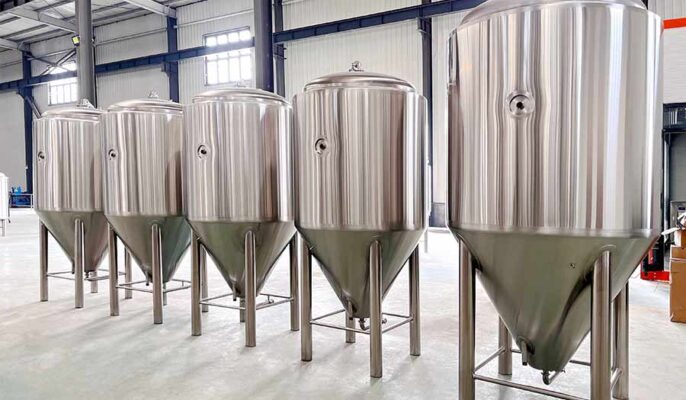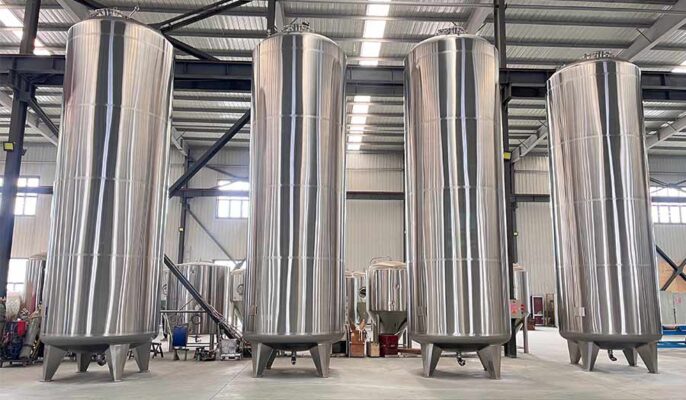Birra serbatoi di fermentazioneI contenitori per la fermentazione della birra sono attrezzature essenziali per la fermentazione in un birrificio. Il processo di fermentazione non solo influisce sul gusto e sul sapore della birra, ma ha anche un impatto diretto sulla produttività e sulla qualità del prodotto. Il numero di vasi di fermentazione necessari in un sistema di produzione dipende da diversi fattori, tra cui le dimensioni del birrificio, il tipo di birra che si intende produrre, il programma di produzione e la capacità di fermentazione richiesta. I recipienti di fermentazione sono disponibili in varie dimensioni e la grandezza necessaria dipenderà certamente dalla portata dell'operazione di birrificazione. Esistono anche diversi tipi di recipienti di fermentazione, quindi è importante scegliere quello giusto per le proprie esigenze.
Panoramica di Vasche di fermentazione
I fermentatori sono utilizzati per immagazzinare il mosto e fermentarlo in birra. I fermentatori sono parte integrante anche del più modesto birrificio domestico. Quasi ogni contenitore in grado di contenere un liquido può essere un potenziale fermentatore. È possibile fermentare prodotti diversi utilizzando lieviti diversi nel recipiente di fermentazione. L'uso del lievito di birra consente la fermentazione del mosto in birra. Questo perché il lievito converte lo zucchero in alcol durante il processo di fermentazione della birra. È anche possibile convertire la biomassa in biogas in un recipiente di fermentazione. È importante notare che un fattore importante nel processo di fermentazione è la quantità di ossigeno. Senza ossigeno, il lievito convertirà una maggiore quantità di zucchero in alcol. Se c'è troppo ossigeno, i lieviti si moltiplicheranno.

Quanti recipienti per la fermentazione Ho bisogno di un processo di birrificazione completo?
Dimensione del lotto
La capacità di ciascun lotto è il fattore principale che determina il numero di recipienti di fermentazione necessari. In genere, lotti più grandi richiedono più recipienti, ma questa relazione non è sempre lineare. Occorre considerare fattori quali il tempo di fermentazione, la pulizia delle apparecchiature e i tempi di inattività per la manutenzione, nonché la produzione richiesta. Ad esempio, per mantenere una produzione settimanale stabile, è necessario un numero sufficiente di recipienti di fermentazione per scaglionare efficacemente i cicli di produzione.
Capacità di produzione
Determinare la quantità di birra che si prevede di produrre in un determinato periodo di tempo: settimanalmente, mensilmente o annualmente. Dividete il volume totale della birra per la dimensione del lotto per determinare il numero di lotti necessari. Conoscere il periodo medio di fermentazione per ogni tipo di birra è fondamentale per calcolare la capacità produttiva.
Per stimare il numero di vasi di fermentazione necessari, dividere la produzione prevista per la dimensione del lotto. In questo modo si otterrà il numero minimo di recipienti necessari per raggiungere gli obiettivi di produzione mensili.
Ad esempio, se la produzione mensile prevista è di 4.000 litri e la dimensione del lotto è di 1.000 litri, sono necessari almeno 4 recipienti di fermentazione. Tuttavia, è importante tenere conto di fattori pratici come la manutenzione, la pulizia e la sovrapposizione dei lotti. Disporre di ulteriori recipienti può aiutare a gestire questi fattori e a garantire operazioni più fluide. Si consiglia di aumentare il numero di vasi di fermentazione leggermente al di sopra del requisito minimo per fornire un cuscinetto.
Tipi di fermentazione e requisiti specifici
Ogni processo di fermentazione ha requisiti unici. Che si tratti di produrre birra, vino, aceto o prodotti caseari, sono necessarie condizioni specifiche come il controllo della temperatura, l'esposizione all'ossigeno o il tempo di invecchiamento. Comprendere la complessità del tipo di fermentazione prescelto aiuta a selezionare il numero e il tipo di recipienti di fermentazione appropriati.
Tempo di fermentazione stimato
La gestione di più fermentazioni simultanee influisce sul numero di recipienti di fermentazione necessari. La gestione simultanea di prodotti o lotti diversi richiede recipienti aggiuntivi e un'attenta programmazione per evitare contaminazioni incrociate o interferenze tra le fermentazioni. Ottimizzare l'uso dei recipienti di fermentazione scaglionando le fermentazioni aiuta a mantenere un programma di produzione coerente.
Se un lotto di prodotto impiega 10 giorni per fermentare e il vostro obiettivo è preparare un nuovo lotto ogni 10 giorni, avrete bisogno di un numero sufficiente di recipienti di fermentazione per sostenere questo ciclo. Ciò può significare avere 10 recipienti di fermentazione in modo che ogni lotto possa fermentare in modo indipendente senza aspettare che il lotto precedente finisca.
Flessibilità e versatilità
Considerate la possibilità di utilizzare un mix di recipienti di fermentazione di dimensioni diverse per aumentare la flessibilità operativa. I recipienti più piccoli possono servire per lotti sperimentali, edizioni limitate o prodotti di nicchia, mentre quelli più grandi sono adatti a produzioni standard e migliorano l'efficienza complessiva. Questa combinazione può adattarsi alle richieste del mercato e consentire la sperimentazione di nuove ricette.
Considerare la sovrapposizione dei cicli
L'uso efficiente dei recipienti di fermentazione comporta la sovrapposizione dei cicli di fermentazione. Mentre un lotto è in fermentazione, un altro può essere avviato o terminato, riducendo al minimo i tempi di inattività e massimizzando la produzione. A seconda dei tempi di fermentazione, una sovrapposizione efficace dei cicli può ridurre il numero di recipienti necessari rispetto al numero di lotti prodotti.
Infrastrutture e limiti di spazio
Lo spazio disponibile e i vincoli infrastrutturali possono limitare il numero di fermentatori che possono essere ospitati in un'area specifica. È fondamentale bilanciare l'efficienza operativa con lo spazio disponibile. L'utilizzo efficace dell'infrastruttura esistente può comportare l'investimento in recipienti di fermentazione più grandi o l'ottimizzazione del layout per ottenere un flusso di lavoro migliore. Assicuratevi che le strutture soddisfino gli standard di sicurezza e di igiene, tenendo conto di potenziali espansioni future.
Bilancio e allocazione delle risorse
Infine, i vincoli di bilancio possono influire sul numero iniziale di recipienti di fermentazione che si possono acquistare. È possibile iniziare con un numero ridotto di recipienti multifunzionali e aumentare gradualmente in base alle richieste di produzione e alle capacità finanziarie. Adeguate i vostri piani per il numero di fermentatori in base ai vincoli di bilancio. Bilanciare il numero ideale di fermentatori con le considerazioni finanziarie può richiedere investimenti graduali e la definizione di priorità in base alle esigenze attuali. Valutando attentamente le dinamiche dei lotti, i tempi di fermentazione, le scale di produzione, i tipi di fermentazione e i requisiti di flessibilità, è possibile adattare l'infrastruttura dei recipienti di fermentazione per ottimizzare l'efficienza e soddisfare i requisiti specifici del lavoro di fermentazione. Naturalmente, potete anche contattare Micet Group, dove gli ingegneri possono personalizzare una soluzione adatta alle vostre esigenze.

Come scegliere il fermentatore della giusta dimensione?
Materiali del fermentatore
Quando si sceglie un recipiente per la fermentazione della birra, il materiale di cui è fatto è una considerazione importante. I materiali più comuni utilizzati per i serbatoi di fermentazione della birra sono l'acciaio inox, l'alluminio e la plastica. L'acciaio inossidabile è la scelta più popolare perché è resistente, facile da pulire e non reagisce con la birra. Anche l'alluminio è una buona scelta perché è leggero e conveniente. I serbatoi in plastica sono più economici di quelli in metallo, ma potrebbero non essere altrettanto resistenti e difficili da pulire.
Spazio di testa
Lo spazio di testa è lo spazio in cima al recipiente di fermentazione che consente l'espansione durante la fermentazione. La quantità di spazio di testa necessaria dipende dal tipo di birra prodotta e dal processo di fermentazione utilizzato.
Ad esempio, le birre che producono molta anidride carbonica durante la fermentazione, come le birre chiare, richiedono uno spazio maggiore per l'espansione. D'altro canto, le birre che producono meno anidride carbonica, come le lager, richiedono uno spazio inferiore.
Forma del vaso di fermentazione
Anche la forma e il design del recipiente di fermentazione possono influenzare il processo di fermentazione. I serbatoi conici sono i più diffusi perché consentono di raccogliere facilmente il lievito e altri sedimenti durante la fermentazione. Tuttavia, anche altre forme, come quella cilindrica, cilindrica o quadrata, possono essere adatte a seconda delle esigenze specifiche del birrificio.
Pressione nominale
Un'altra considerazione importante è la pressione nominale del recipiente di fermentazione. Il fermentatore deve essere in grado di sopportare la pressione creata durante il processo di fermentazione senza compromettere l'integrità del fermentatore stesso. I valori di pressione sono solitamente misurati in libbre per pollice quadrato (PSI) e il fermentatore deve essere adatto al tipo di birra che si desidera produrre.
Accessori
Anche gli accessori di cui è dotato il fermentatore possono influire sulla sua idoneità al birrificio. Alcuni fermentatori sono dotati di accessori aggiuntivi come termometri, manometri o porte di campionamento che possono aiutare a monitorare il processo di fermentazione. Altri accessori possono essere i pozzetti per facilitare l'accesso al fermentatore, i bracci per il pipettaggio o i vetri spia.
Consultare un professionista
Se non siete sicuri del recipiente di fermentazione più adatto al vostro birrificio, è meglio consultare un professionista. Micet Group, ad esempio, dispone di ingegneri che possono aiutarvi a valutare le vostre esigenze specifiche e consigliarvi la soluzione migliore per la vostra attività.




